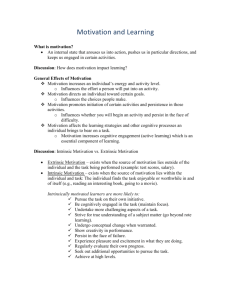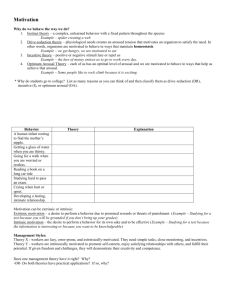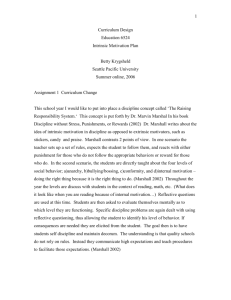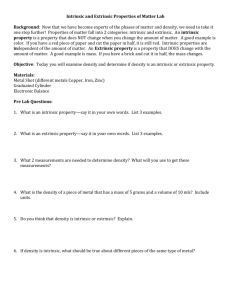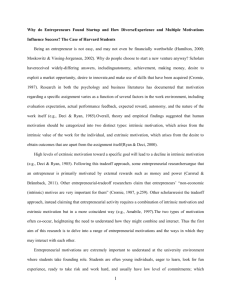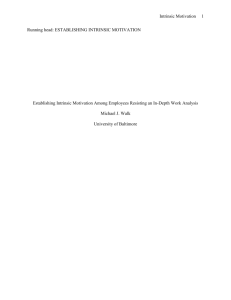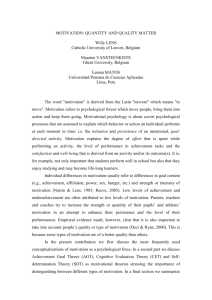Motivation & Prior Knowledge: Impact on Student Learning
advertisement
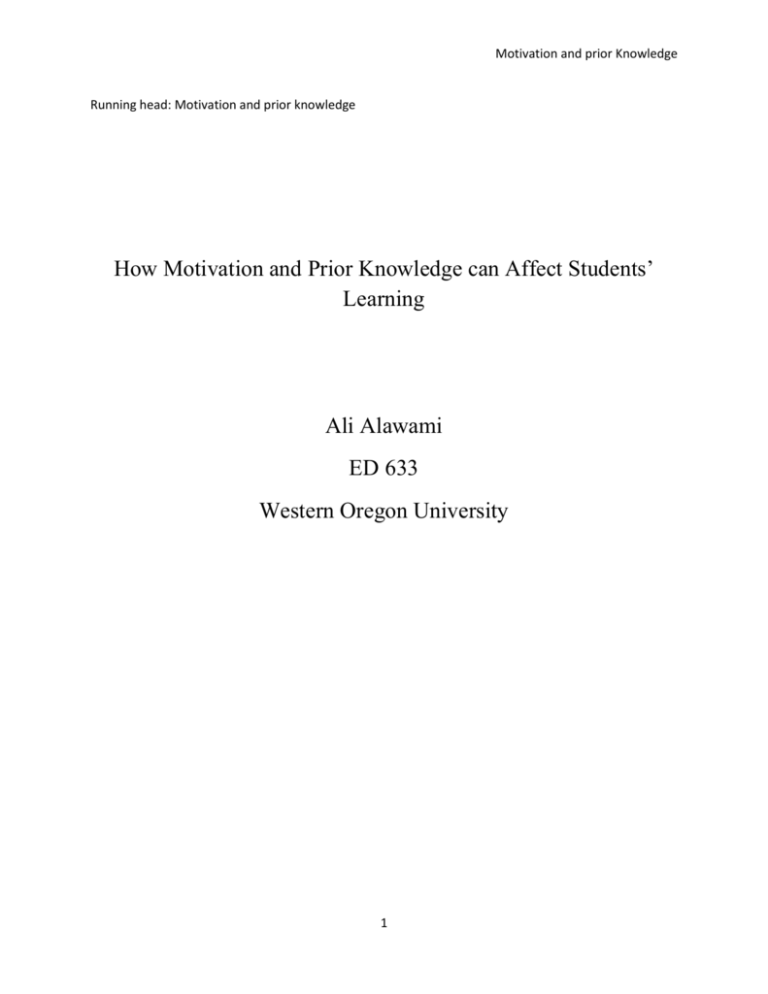
Motivation and prior Knowledge Running head: Motivation and prior knowledge How Motivation and Prior Knowledge can Affect Students’ Learning Ali Alawami ED 633 Western Oregon University 1 Motivation and prior Knowledge Introduction I think we have to know how to assess students’ previous knowledge first. In that way, we will know if the students really have previous knowledge or not because it could be that students have never heard about a specific thing. Previous knowledge is not always positive. It is not always something that we can rely on it and build on it. Some students may have bad feeling about a specific course or topic which may affect their learning. Another way of gaining negative previous knowledge is listening to others’ negative experience. By knowing their previous knowledge, we will be able to determine whether to build on it or try to change it. If students have positive previous knowledge, we, as teachers, have to do our best to connect between their prior knowledge and the new information that we want to introduce them to. Therefore, learning will be more interesting and logical. One form of prior knowledge is motivation. In my short teaching experience, I came through many obstacles that made me think more about students and how to help them learn. One of the major problems that I have seen in almost all students that I had taught is lack of motivation. Students had no motivation for learning. Some of them were coming to school only because their parents were forced them. If they had the choice, I am sure they would choose not to go to school. I spoke with some of my colleagues about that and they were saying the same things, “Students have no motivation.” They did not try to solve it. I talked with my students trying to understand the problem and I always heard the same causes from all of them. They were saying, “Why should we study? We will not be able to go to college and then we will not get a job.” These were like stumbling blocks. I spent many classes trying to make my students change their minds and see thing from different way. From that time I was thinking about prior knowledge especially when it is negative and how it can affect students’ learning. 2 Motivation and prior Knowledge In the beginning, I was only thinking about prior knowledge as the knowledge that students have about subjects that they studied in school, or relative knowledge they had studied before. And I was only concerned about how teachers can make a connection between the prior knowledge and new information they want to present. Thinking deeply about the inquiry led me to many different questions that I would like to answer. My goal from this literature review is to explain the types of motivation and how prior knowledge can affect students learning. How can we use an understanding of prior knowledge to facilitate students who are not motivated or have bad experience about specific topic? The focus of my literature review is “How prior knowledge and motivation can affect students’ learning?” Every student has prior knowledge, even first grade students. In the beginning, I would like to define the prior knowledge. Prior knowledge is the experience, information, beliefs, or motivations that someone has about something. Specifically, this literature review further defines intrinsic and extrinsic motivations and explores how each type of motivation affects learning. Motivation In this section, the discussion will be about the types of motivations that affect students’ learning and how they might contribute to their learning. Knowing how and why second language learners are motivated might help facilitate acquiring a foreign language. According to Gardner and Lambert (1972), being successful and making achievements in learning a second language are linked with learners’ feeling of that language and the purpose of learning that language (motivation). Students’ learning and their abilities to perform well in a foreign language are connected with their motivations. Knowing the reason of learning, in other words, 3 Motivation and prior Knowledge the factors that influence students’ learning would help teachers to support students’ learning. Deci and Ryan (1985), presented motivation in two major concepts: intrinsic motivation and extrinsic motivation. Intrinsic Motivation When a learner enjoys learning and sees it as internal interest and happiness rather than for external gains, this called intrinsic motivation. Deci and Ryan (2000), “performing an activity for inherent satisfaction rather than for some separable outcome.” In other words, it is engaging in a behavior or activity because it is personally rewarding. It has to do with the personal effort and the desire to continue to do or achieve a specific thing which is called integrative motivation (Horwitz, 1987, 2001). Research shows that learners are more motivated when they have relevance to their learning and when they feel that the curriculum is tailored to meet their interest and needs. Brophy (2010), describes motivation to learn as a cognitive process that stimulate participations, interest, and success in learning. It is simply mean what people do without external inducement. Malone and Lepper (1987), develop the claim that in order to design environments that are intrinsically motivating two types of factors should contribute in the process. The first one is individual factors which are operated when someone is working alone. The second type is interpersonal factors which play a role only when someone else interacts with the learner. The first factor is challenge; when people are working toward personal goals, they are more motivated. The second one is curiosity; that can be seen when there is something in the physical environment attracts the learner’s attention. The third one is control; when someone has a tendency to control what happens to them. The fourth one is competition; students feel satisfied 4 Motivation and prior Knowledge when their performance is compared favorably to others. The fifth one is cooperation; helping others to achieve their goals makes students feel satisfaction. The last one is recognition; students feel satisfaction when others recognize and appreciate their accomplishments. Intrinsic motivation depends on the fulfilment of three basic psychology needs described by self-determination theory (SDT), Deci and Ryan. First one is the need for autonomy which is the need to feel that someone is implementing a task of his own choice. The second one is the need for competence in learning which is the need to feel capable to learn or to study. The last one is relatedness which is the need to feel connected or belonged with fellow pupils and the teachers. Autonomy in learning and autonomy-support by teachers has been found to make students’ motivation more self-determined, Black and Deci (2000). Kusurkar, Croiset and Cate (2011), presented 12 practical tips on how to engage in autonomy-supportive teaching behaviors in order to enhance intrinsic motivation. First, teachers have to find out what students want to learn and form the session around the needs. Second, build the lesson around the students’ needs help to create a state of self-determined motivation. Third, encourage students to participate. Fourth, encourage students to accept more responsibility for their learning. Fifth, provide structured guidance to the students during the teaching sessions. Sixth, provide optimal challenges during teaching. That can be done through asking students to make presentations. Seventh, teachers have to give positive feedback to students on the process of learning to show the gap between the current and desired learning. Eighth, teachers have to create an emotional environment to support students. Ninth, teachers have to listen to students and empathize with them if students express their disinterest or dissatisfaction. Tenth, it is that all activities are interesting to all students. Therefore, it is important to think about how to handle with students 5 Motivation and prior Knowledge who are not motivated in certain point. Eleventh, teachers have to allow students to make their choices in order to bring in autonomy. Finally, teachers have to use the right words while guiding students. For example, replace “you must do this” with “if you want to succeed, you need to do this”. Extrinsic Motivation The extrinsic motivation occurs when students are motivated to engage in an activity or work to achieve something in order to earn a reward or avoid a punishment. Dornyei (2005) develops the claim that extrinsic motivation is related to self. It is a tendency to do something in order to gain separate outcome such as good grades or qualification to enter a university. According to Deci and Ryan (2000) extrinsic motivation is divided into four distinct forms: external regulations, introjected regulations, identified regulation, and integrated regulations. The most extrinsic type of motivation is the external regulation in which someone is motivated because of external demand or reward. The second type of extrinsic motivation is introjected regulation in which the individual’s ego has to be maintained. Third, identified regulation is when someone is trying to accomplish something because it is personally important; it is related to valuing a goal. The last subtype is the integrated regulation. It is fully associated with the self. It is included in a person’s beliefs about personal needs. Motivated students participate fully in classroom activities and are more successful. There has been an inconclusive debate about whether to depend on extrinsic motivators like rewards or not. This kind of motivation should be used carefully because it may undermine students’ interests and engagement. However, a recent study conducted by Marinak and Gambrell (2010) found that students participation can be 6 Motivation and prior Knowledge increased when they offered rewards related to the desired behavior. Students should learn because learning gives them a feeling of accomplishment. Prior Knowledge Many researches seem to validate the view that learning is influenced by the students’ prior knowledge. Most broadly, prior knowledge has been seen as useful and teachers can build on to facilitate students’ learning. When students come to a class to learn, they do not have blank minds. They have some form of information which might not be directly related to what a teacher wants to teach but it can be used to connect it with the new information to facilitate their learning. Teachers should be aware of that. Students use what they knew as the first step to make guess; they may use phrases like “I know about this” or “I have seen this before”. According to Glynn (1995), students use existing information to understand new information. One important aspect of learning is to help students to acquire new knowledge by connecting it with what they already know. Marizano, Pickering and Mctighe (1993), claim that teachers must follow certain steps when they want to teach students to ensure successful teaching. The first step is helping students to recall their prior knowledge. Secondly, present new information or concept. Thirdly, compare or associate new information with the existing information. Fourthly, form generalization with both old and new information. Finally, apply the expanded concept with its element of old and new information. Students will feel interested if new information is connected with previous metal states, the new will naturally be interesting, Herbart (1993). 7 Motivation and prior Knowledge Prior knowledge in teaching Students may have different level of prior knowledge, some may have a great deal of knowledge others may have very little knowledge. Therefore, teachers have to measure the level of prior knowledge in a specific topic. This can be achieved in the following way. Teachers have to ask general questions and then make them more specific. Then, trying to summarize what the students said and write different statements on the board to narrow down the topic. By doing so, students’ prior knowledge has been activated. Teachers can connect what the students said with the new topic. Conclusion The consensus view seems to be that students’ learning and performances are affected by their motivations and prior knowledge. Different studies have been conducted in this area and the results when teachers know their students’ motivations and use it as a support to teach students. Some researchers have connecting the success of learning a new language with the purpose of learning (motivation). Deci and Rayn categorized motivations into two groups; intrinsic motivation and extrinsic motivation. They went further in explaining each category and how it affects students’ learning. The first category is intrinsic which can be seen when students enjoy what they learn. Learners do not care about grades and no one pushing them to learn. The second category is extrinsic motivation which is opposite to the intrinsic. This takes place when the main concern is grades or to avoid punishments. There are four faces of extrinsic motivation; external regulations: external demand or rewards, introjected regulations: maintained the ego, identified regulations: valuing a goal, and integrated regulations which is associated with the self. Marink 8 Motivation and prior Knowledge and Gambrell see that rewarding students can increase their encouragement but students should be motivated to learn because it gives them a feeling of accomplishment. Prior knowledge also plays an important role in learning. Prior knowledge is not only they information that students have about specific topic but it is also the feeling that they have about a specific topic which might be positive or negative. Assessing students’ prior knowledge is the first step to that teachers have to do to make connections between it and the new topic and that can be achieved by asking students general questions. 9 Motivation and prior Knowledge Reference Page Cole, J. E. (2014). Motivating students to engage in close reading. Illinois Reading Council Journal, 42(4),19-28. Chen, Y. E. & Kraklow, D. (2014). Taiwanese college students’ motivation and engagement for English learning in the context of internationalization at home: A comparison of students in EMI and Non-EMI programs. Journal of Studies in International Education,19(1) 46 64. DOI: 10.1177/1028315314533607 Engin, A. (2009). Second language learning success and motivation. Social Behavior and Personality, 37(8), 1035-1042.DOI 10.2224 Rubenfeld, A, Sinclair, L. Clement, R. (2007). Second language learning and acculturation: The Personality, 37(8), 1035-1042.DOI 10.2224 Hailikari, T. (2009). Assessing university students’ prior knowledge: Implications for theory and practice. University of Helsinki, Department of Education. ( report No. 227). Kusurkar, R. A., Croiset, G., & Ten Cate, T. J. (2011). Twelve tips to stimulate intrinsic Motivation in students through autonomy-supportive classroom teaching derived from self-determination theory. Medical Teacher, 33(12), 978-982. Doi:10.3109 Thompson, B. R., & Thornton, H. J. (2002). The transition from extrinsic to intrinsic motivation In the college classroom: A first-year experience. Education, 122(4), 785. Asiyai, R. (2014). Students' perception of the condition of their classroom physical learning environment and its impact on their learning and motivation. College Student Journal, 48(4), 714-723. Froiland, J. M. (2015). Parents’ weekly descriptions of autonomy supportive communication: Promoting children’s motivation to learn and positive emotions. Journal of Child and Family Studies, 24(1), 117-126. 10 Motivation and prior Knowledge Kim, S., & Rehder, B. How prior knowledge affects selective attention during category learning: An eyetracking study. Psychonomic Society, Inc, 2010. DOI 10.3758 Beskeni, R. D., Yousuf, M. I., Awang, M., & Ranjha, A. N. (2011). The Effect of Prior Knowledge in Understanding Chemestry Concepts by Senior Secondary School Students. International Journal of Academic Research, 3(2). Malone, T. W., & Lepper, M. R. (1987). Making learning fun: A taxonomy of intrinsic motivations for learning. Aptitude, learning, and instruction, 3(1987), 223-253. 11

